A Wonder Molecule to Fight COVID-19 and Other Viruses
- LeeHealthDomain

- Jul 8, 2022
- 4 min read
Lactoferrin, making quite a buzz lately ever since the outbreak of Covid-19 and the medical world is moving heaven and earth trying to put an end to the pandemic.

Well, if you are still wondering what Lactoferrin is, it’s not fresh from the oven, your body makes it every day. Lactoferrin is a protein found naturally in milk. It’s also produced in other bodily secretions, including tears and saliva, and by some immune system cells.
Lactoferrin is found in body fluids such as your eyes, nose, and mouth to protect you from pathogens. When exposed to viruses or bacteria, lactoferrin works to neutralise or suppress the infection. Lactoferrin is also found in certain white blood cells, so if pathogens manage to get past your initial line of defence, those white blood cells will go to the site of infection, burst open to release lactoferrin, and kill it. It's all quite dramatic.
Naturopath
Colostrum, the first form of mother's milk produced after a baby is born, has the greatest concentration of lactoferrin of any type of mother's milk. It has exceptional abilities to protect children from becoming sick before their own immune systems are completely established and ready to do so.
In adults, it is a crucial component of the immune system's defences against infectious diseases.
Lactoferrin is found in mucus, saliva, and other secretions, and it helps prevent infections from entering the body via the mucous membranes that line the mouth cavity, the nasal cavity, the airways, and the digestive system.
The fact that lactoferrin may provide protection against a wide variety of viruses is one of its most interesting properties. It has been shown to exhibit potent antiviral activity against a variety of viruses, including those that are responsible for the common cold and flu as well as HIV and the viruses that cause hepatitis B and C.
Science
Viruses and bacteria are not the same things. A bacterium is a living entity, and most of them contain all of the components they need for life, reproduction, and so on.
A virus is just a piece of data. A virus stores its information in a cell, such as a bacterial cell, human cell, or animal cell. It includes instructions that direct a cell to produce more of the virus itself, just as a computer virus infecting a computer instructs the computer to produce more of itself. Viruses are not living organisms.
Its only purpose in life is to create more of itself. Causing sickness along the route may or may not be beneficial—if it kills the cells too quickly, it has less time to escape and find a new host.
The primary mechanism by which lactoferrin protects against viral infections is that it prevents viruses from attaching themselves to cells.
This may put a halt to the virus in its tracks, preventing it from causing any difficulties in the future. It is impossible for a virus to cause sickness if it cannot connect to cells and penetrate them.
Lactoferrin accomplishes this goal in a few distinct ways:
· It does this by attaching to the virus directly, which inhibits the ability of the virus' surface proteins to detect binding sites on the surface of cell membranes.
· It does this by binding to spots on the surface of the cell's outer membrane that viruses seek to infect. Heparan sulphate, for instance, is a chemical that may be found on the surface of cells and is a frequent target for many different viruses.
According to the findings of numerous research, Lactoferrin binds to structures that contain heparan sulphate, an action that has the potential to stop viruses from detecting and entering cells.

Lactoferrin's other immunity-boosting benefits


Imunolact ®
Imunolact® is one of its kind immune support supplements in India – a tablet with Bovine Lactoferrin, Zinc, and Vitamin C. Imunolact is backed by Scientists, Doctors, and wellness experts.
Imunolact® is perfect for those who are always on the go since its tablet form allows it to start working more rapidly in the mouth (and avoids unpleasant stomach fluids). Because those over the age of 12 and adults may take Imunolact® at the first symptom of a scratchy throat or sniffle to nip it in the bud, it is an essential item to keep in the medicine cabinet at this time of year.
References
1. Berlutti F, Pantanella F, Natalizi T, et al. Antiviral properties of lactoferrin--a natural immunity molecule. Molecules. 2011Aug 16;16(8):6992-7018.
2. Drago-Serrano ME, Campos-Rodriguez R, Carrero JC, et al. Lactoferrin: Balancing Ups and Downs of Inflammation Due to Microbial Infections. Int J Mol Sci. 2017 Mar 1;18(3).
3. Moreno-Exposito L, Illescas-Montes R, Melguizo-Rodriguez L, et al. Multifunctional capacity and therapeutic potential of lactoferrin. Life Sci. 2018 Feb 15;195:61-4.
4. Wakabayashi H, Oda H, Yamauchi K, et al. Lactoferrin for prevention of common viral infections. J Infect Chemother. 2014 Nov;20(11):666-71.
5. Chien YJ, Chen WJ, Hsu WL, Chiou SS. Bovine lactoferrin inhibits Japanese encephalitis virus by binding to heparan sulfate and receptor for low density lipoprotein. Virology. 2008;379(1):143-151.
6. Chen JM, Fan YC, Lin JW, et al. Bovine Lactoferrin Inhibits Dengue Virus Infectivity by Interacting with Heparan Sulfate, Low-Density Lipoprotein Receptor, and DC-SIGN. Int J Mol Sci. 2017 Sep 12;18(9).
7. Pietrantoni A, Di Biase AM, Tinari A, et al. Bovine lactoferrin inhibits adenovirus infection by interacting with viral structural polypeptides. Antimicrob Agents Chemother. 2003 Aug;47(8):2688-91.
8. Scala MC, Sala M, Pietrantoni A, et al. Lactoferrin-derived Peptides Active towards Influenza: Identification of Three Potent Tetrapeptide Inhibitors. Sci Rep. 2017 Sep 6;7(1):10593.
9. Zheng Y, Zhang W, Ye Q, et al. Inhibition of Epstein-Barr virus infection by lactoferrin. J Innate Immun. 2012;4(4):387-98.
10. Zhang Y, Lima CF, Rodrigues LR. Anticancer effects of lactoferrin: underlying mechanisms and future trends in cancer therapy. Nutr Rev. 2014 Dec;72(12):763-73




Comments